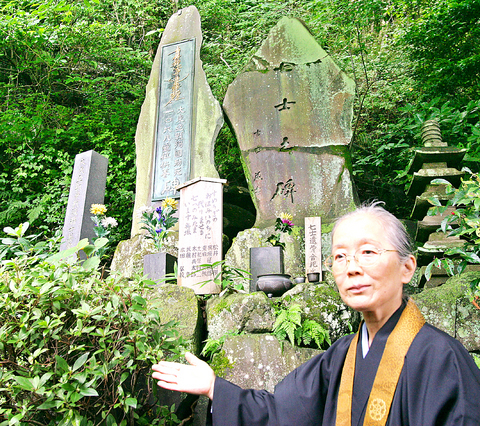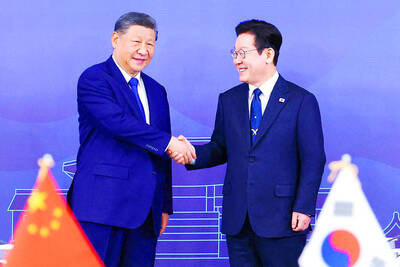As tensions rise in Asia over a Tokyo shrine honoring war dead, actual remains of Japan's top war criminals lie here at a quiet temple dedicated to the Buddhist goddess of mercy.
On a wooden hillside overlooking Atami Bay, some 90km southwest of Tokyo, a statue of the goddess, Kannon, stands with half-closed eyes which, the nuns say, are gazing toward China.
Ashes of seven top war criminals including General Hideki Tojo, the prime minister who ordered the attack on Pearl Harbor, were buried on the temple grounds among other individual sites in Japan after they were hanged in December 1948 by order of a US-led tribunal.

PHOTO: AFP
Flanked by two stone lions and Japanese flags, the temple in 1959 set up a marker to the "seven warriors." A nearby monument honors 1,068 Japanese who were executed as war criminals or died in prison elsewhere in Asia after Japan lost the war and its empire.
But today the Koa Kannon temple is deserted save for two elderly nuns, the Itami sisters, who live here permanently and welcome the rare visitors.
"Around 80 people come here each month. They are people of all backgrounds. Some of them are passionate about history and there are young people as well," said the elder sister, Myotoku Itami, 63, a petite, smiling woman with a shaved head and a somber robe.
It is a world away from the scene at the Yasukuni Shrine, which was built in the heart of Tokyo by the state in 1869 and now lists the names of 2.5 million war dead including top war criminals such as Tojo.
The Yasukuni Shrine has become a rallying ground for war veterans and nationalists. Prime Minister Junichiro Koizumi has visited the Shinto site every year, saying he is praying for all war dead, provoking furious protests from Asian nations invaded by Japan.
Koizumi, who steps down next month, has sent signals he will visit tomorrow, the sensitive anniversary of Japan's 1945 surrender, despite rising domestic opposition.
At Koa Kannon, in another era, commandos of the now defunct far-left Japanese Red Army in 1971 partly dynamited the monument to the seven war criminals. A black stain still remains on the stone marker.
The Japanese traditionally hold Buddhist funeral rites, although the indigenous Shinto faith was elevated to the state religion during World War II.
General Iwane Matsui -- another of the seven war criminals whose ashes were deposited here -- built the Koa Kannon temple in 1940 and would pray here every day.
Supporters of the temple point out proudly that Matsui built it in honor not only of Japanese soldiers but also Chinese troops who died in war during Japan's invasions and occupation of its neighbor.
"It is natural for victors to venerate the souls of the dead. Whether one wins or loses, one must stop hatred from perpetuating or else war will never end," said veteran Tasaburo Tokutomi, 80, president of the Association of Friends of Koa Kannon.
Matsui was hanged for his campaign in China which included the 1937 capture of the eastern city of Nanjing, where Japanese troops went on a rampage of murder and rape of the civilian population.
The massacre, which remains an issue of deep anger for China, left 300,000 people dead, according to Chinese historians. US-led war crimes trials documented 140,000 dead.
A black lacquer box at the temple keeps enclosed the written names of 23,104 Japanese soldiers who died under Matsui's leadership.
In 1944, another list was added to the temple honoring other Japanese who died during the "Great East Asia War," as Japan called its invasions of Asia.
There is no question here of debating whether Japan was responsible for the war.
"There is no consensus on the interpretation of the war," Tokutomi said. "Sixty years have not been enough to erase the [anti-Japanese] prejudices and reveal the truth."
Underneath a wooden ceiling decorated by a magnificent dragon, the temple has a mish-mash of mementos to both Japan and China.
At the entrance, a calendar depicts the family of Crown Prince Naruhito and his US-educated wife Masako. On the walls are General Matsui's uniform, a bamboo sword, etchings of soldiers and old photographs, including one of Radha Binod Pal, the virulent Indian critic of the West who was the sole judge at the war crimes trials to acquit Japanese leaders.
Two wall paintings show scenes of the Chinese countryside from 1939-1940 and the altar has two glazed wooden placards dedicated to the memory of Japanese and Chinese soldiers.
In the same vein, the statue of the goddess Kannon is mixed with earth from Japan and the battlefields of China.
"The Japanese people ought to be proud of the spirit of Koa Kannon, which honors both the souls of enemies and allies," said Yasuo Nara, 76, a military historian.
But few Japanese trek to Koa Kannon and the enduring controversies about history have cost Japan dearly in terms of relations with its neighbors, even as the generation born after the war takes political power.
"It's difficult for young people to understand but it's important to send a message," said Tokutomi, who was a 19-year-old pilot in training when the war ended.

‘CHILD PORNOGRAPHY’: The doll on Shein’s Web site measure about 80cm in height, and it was holding a teddy bear in a photo published by a daily newspaper France’s anti-fraud unit on Saturday said it had reported Asian e-commerce giant Shein (希音) for selling what it described as “sex dolls with a childlike appearance.” The French Directorate General for Competition, Consumer Affairs and Fraud Control (DGCCRF) said in a statement that the “description and categorization” of the items on Shein’s Web site “make it difficult to doubt the child pornography nature of the content.” Shortly after the statement, Shein announced that the dolls in question had been withdrawn from its platform and that it had launched an internal inquiry. On its Web site, Le Parisien daily published a

China’s Shenzhou-20 crewed spacecraft has delayed its return mission to Earth after the vessel was possibly hit by tiny bits of space debris, the country’s human spaceflight agency said yesterday, an unusual situation that could disrupt the operation of the country’s space station Tiangong. An impact analysis and risk assessment are underway, the China Manned Space Agency (CMSA) said in a statement, without providing a new schedule for the return mission, which was originally set to land in northern China yesterday. The delay highlights the danger to space travel posed by increasing amounts of debris, such as discarded launch vehicles or vessel

RUBBER STAMP? The latest legislative session was the most productive in the number of bills passed, but critics attributed it to a lack of dissenting voices On their last day at work, Hong Kong’s lawmakers — the first batch chosen under Beijing’s mantra of “patriots administering Hong Kong” — posed for group pictures, celebrating a job well done after four years of opposition-free politics. However, despite their smiles, about one-third of the Legislative Council will not seek another term in next month’s election, with the self-described non-establishment figure Tik Chi-yuen (狄志遠) being among those bowing out. “It used to be that [the legislature] had the benefit of free expression... Now it is more uniform. There are multiple voices, but they are not diverse enough,” Tik said, comparing it

RELATIONS: Cultural spats, such as China’s claims over the origins of kimchi, have soured public opinion in South Korea against Beijing over the past few years Chinese President Xi Jinping (習近平) yesterday met South Korean counterpart Lee Jae-myung, after taking center stage at an Asian summit in the wake of US President Donald Trump’s departure. The talks on the sidelines of the APEC gathering came the final day of Xi’s first trip to South Korea in more than a decade, and a day after his meeting with the Canadian prime minister that was a reset of the nations’ damaged ties. Trump had flown to South Korea for the summit, but promptly jetted home on Thursday after sealing a trade war pause with Xi, with the two